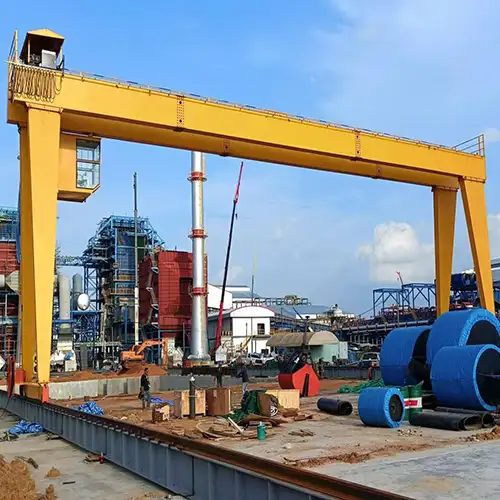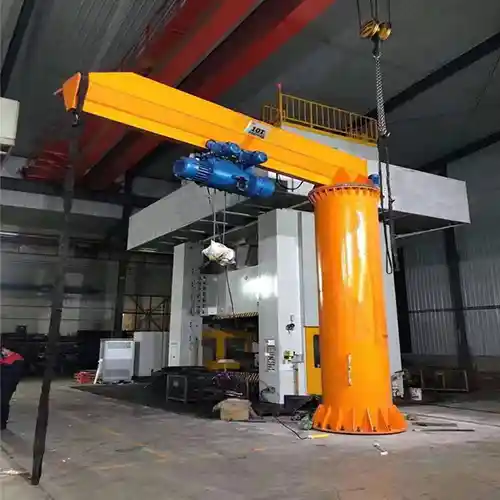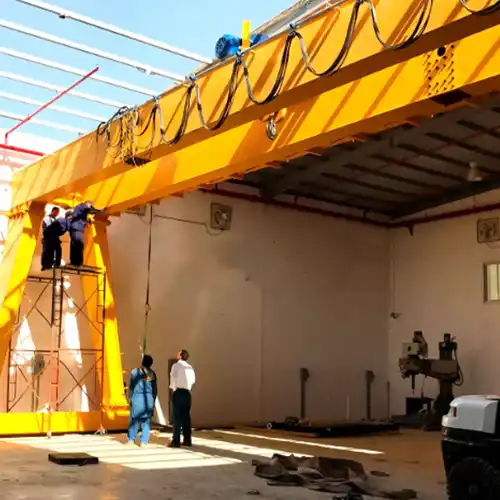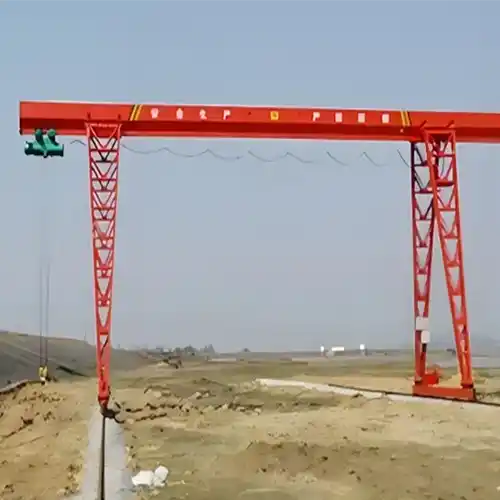10 Ton Goliath Gantry Crane Installation, Commissioning & Operation
10 ton Gantry Goliath Crane for sale in Thailand, featuring expert installation, commissioning & efficient operation for optimal performance.Click now!
Category: 10 Ton Gantry Crane
Your Trusted Goliath Gantry Crane Manufacturer & Supplier
10 Ton Goliath Gantry Crane for Sale, Installation, Commissioning & Operation
10 ton Gantry Goliath Crane for sale in Thailand, featuring expert installation, commissioning & efficient operation for optimal performance.Click now!
10 Ton Gantry Crane with Clamshell Grab Bucekt Installation & Commissioning, Custom Goliath Gantry Crane for Sale
Overview of the 10 Ton Gantry Goliath Crane
The 10 Ton Gantry Goliath Crane is an impressive piece of machinery designed specifically for heavy lifting tasks, such as handling sugarcane ash. With a double girder design, this crane is built for durability and efficiency, ensuring you can tackle demanding jobs without a hitch. It boasts a lifting capacity of 10 tons and a generous span of 27 meters, making it ideal for large operational areas.
One of the standout features of this crane is its clamshell grab bucket, which allows for precise loading and unloading. This attachment is perfect for materials that require careful handling, like sugarcane ash, which can be tricky to manage. Plus, with a lifting height of 10 meters, it provides the flexibility to work in various settings, from warehouses to outdoor sites.
When considering installation in Thailand, it's important to evaluate the local conditions. The crane's specifications must align with the project site to ensure optimal performance. Pay close attention to the foundation; it needs to be sturdy enough to support the crane's weight and withstand operational stresses.
If you're new to gantry cranes, here's a pro tip: always consult with an expert during the setup phase. A well-prepared installation can save you from headaches down the road. Proper training for your team on operating the crane and its attachments is also key. It not only boosts safety but enhances overall efficiency. Remember, a little preparation goes a long way in ensuring smooth operations!
10-Ton Double Girder Gantry Crane Project for Sugarcane Ash in Thailand
Main specifications of 10 ton double girder gantry crane projects
- Crane Type: This is a double girder gantry crane, designed for heavy-duty applications, providing robust structural integrity and stability.
- Crane Capacity: The crane has a maximum lifting capacity of 10 tons, suitable for handling substantial loads with ease.
- Crane Span: With a span of 27 meters, this crane can cover a wide area, allowing for effective material handling over large distances.
- Crane Lifting Height: The crane offers a lifting height of 10 meters, accommodating various operational needs in the specified project area.
- Below Hook Device: The clamshell grab bucket is designed for efficient loading and unloading of materials, particularly suited for handling bulk items like sugarcane ash.
- Object Handling: The primary material to be handled is sugarcane ash, which requires a reliable and efficient lifting mechanism due to its bulk characteristics.
- Project Location: This project is situated in Thailand, emphasizing the need for cranes that can withstand local environmental conditions while maintaining operational efficiency.
This gantry crane is engineered to enhance productivity in material handling operations, particularly in agricultural and processing industries.
Installation Process
1. Site Preparation
Getting your site ready is crucial for a successful crane installation. Start by evaluating the ground stability; this means checking for solid footing and good drainage. If the soil is soft or unstable, you might need to reinforce it. Next, focus on foundation preparation. Ideally, you'll want to use robust concrete pads that meet local regulations. It's wise to consult with an engineer to ensure your foundation can bear the crane's weight, preventing future headaches.
2. Delivery and Assembly
Once the site is set, it's time for component delivery. Plan ahead to make sure access routes are clear for those big delivery trucks. Upon arrival, double-check that all parts are accounted for; missing components can delay the project. For structure erection, bring in cranes or hoisting equipment to lift the heavier pieces into place. A skilled team is essential here; they'll need to bolt or weld the girders securely while using a laser level to check for perfect alignment. Precision at this stage pays off later!
3. Installation of Systems
When it comes to installing the lifting mechanism and electrical systems, stick to the manufacturer's guidelines closely. Make sure everything is connected properly, from the control panels to emergency stops and overload protection systems. Once that's done, it's time for calibration. Test the hoisting mechanism thoroughly, ensuring all movements are smooth and responsive. A well-calibrated crane is safer and more efficient.
4. Final Adjustments and Inspections
Now, onto the final adjustments. Ensure that all moving parts, especially the clamshell grab bucket, are aligned perfectly for smooth operation. Don't skip the safety inspection; perform a thorough checklist to look for loose bolts, electrical issues, and overall compliance with safety standards. If you're unsure, it's a good idea to bring in a third-party safety inspector to give you peace of mind. Remember, taking these steps seriously can save you from costly errors down the line!
Commissioning Process
1. Initial Testing
Once your crane is installed, it's time for initial testing. Start with functional tests in a controlled environment. Aim for at least three cycles of hoisting, lowering, and lateral movement. This helps identify any anomalies right away. Next, focus on the clamshell grab bucket. Load it with sugarcane ash to check if it opens and closes smoothly and can securely lift and release the material. This practical test ensures that your crane is ready for the real deal!
2. Safety System Checks
Now, let's move on to safety system checks. It's crucial to test all safety features, including emergency brakes, limit switches, and overload alarms. Don't forget to document these results for compliance records. This isn't just paperwork; it's about keeping your operations safe. Make sure that emergency stop systems are clearly marked and easily accessible to operators. In an emergency, every second counts!
3. Operational Training
With the testing done, it's time for operational training. Provide hands-on sessions that include simulations of potential emergency scenarios. This is where theory meets practice, so it's vital. Train your personnel on safety protocols, emphasizing the importance of wearing personal protective equipment (PPE) and knowing emergency evacuation procedures. A well-trained team not only operates more efficiently but also creates a safer work environment. Remember, preparation is key to success!
Operation Guidelines
1. Pre-Operation Inspection
Before each shift, it's essential to perform a pre-operation inspection. Create a checklist for operators to follow, focusing on mechanical components, safety devices, and control systems. This ensures everything is in top shape and ready for action. Don't forget to verify that all controls function correctly, including any remote controls. A quick test can save you from headaches later!
2. Loading and Unloading
Proper loading and unloading techniques are vital for safe operations. Train operators on the best practices for positioning and operating the clamshell grab bucket. Visual aids or markings can help ensure correct alignment, making it easier for everyone involved. Implement a weight monitoring system or scale to prevent overloads. Keeping the crane within its limits is key to avoiding accidents and extending its lifespan.
3. Maneuvering the Crane
When it comes to maneuvering the crane, smooth and gradual movements are critical. Emphasize this to your operators; it's not just about speed. Conduct regular drills to practice handling techniques under various load conditions. This not only builds confidence but also improves safety. Also, establish clear communication protocols. Whether you're using hand signals or radios, good communication between the crane operator and ground personnel can prevent accidents and ensure everyone is on the same page.
4. Post-Operation Procedures
After the job is done, have a solid plan for post-operation procedures. Create a standard method for securing the crane, including locking out controls to prevent accidental operation. A final inspection should be part of this routine to catch any issues that may have arisen during use. Additionally, implement a logbook system for operators to document maintenance issues, safety concerns, or anything unusual they observe. This documentation will be invaluable for future reference and can help you stay ahead of potential problems. Remember, a little diligence now can save you time and money later!
Conclusion: Customized Gantry Crane for Your Needs.
In conclusion, adhering to these practical steps for installation, commissioning, and operation ensures that your 10-ton Goliath gantry crane is not only effective but also safe for various applications, including sugarcane ash handling. Proper installation sets the foundation for reliable performance, while thorough commissioning processes confirm that all systems are functioning as intended.
During operation, prioritizing pre-operation inspections and rigorous training for operators can significantly reduce risks and enhance efficiency. Remember, a well-trained team equipped with the right knowledge and tools can handle challenges confidently, ensuring smooth operations day in and day out.
Ultimately, by implementing these guidelines, you'll maximize the crane's capabilities, improve productivity, and create a safer work environment. Investing time in these processes pays off by preventing costly downtime and fostering a culture of safety and responsibility among your crew. With these practices in place, you can operate your gantry crane with peace of mind, knowing that you are doing everything possible to achieve optimal safety and operational efficiency.
Related Products

Latest project
150 Ton Overhead Crane Installation Feedback – Paraguay Case
QDX 150 ton overhead crane in action in Paraguay. Installation photos, video, and client feedback show performance, safety, and heavy-lifting efficiency.
Free consultation to Confirm Parameters & Specifications and Get
Latest Crane Price & Crane Rate.
- Types of overhead cranes : _______?
- Optional: Overhead travelling crane, goliath gantry crane,Slewing jib crane, Single girder or double girder crane,small portable crane or kbk crane, etc.
- Capacity of overhead crane: _______?
- Optional: 0.25ton, 0.5 ton, 1 ton, 2 ton, 3ton, 5 ton, 10 ton,15ton, 20ton, 25 ton, 30ton,35ton, up to 550ton, etc.
- Crane span & lifting height : _______?
- Crane travelling length : _____?
- Control of overhead crane:_______?
- Optional: pendant/ remote/cabin control
- Voltage supply of overhead crane:_____?
- Eg,: 380V50/60HZ,3Phase or others,etc.
- Application/usage of crane:_______?
- Eg,: Steel mill, ,injection mold, cement,stone, concrete,granite, general manufacturing, etc.
Just leave a message via the contact form and our hoist and crane engineer will contact you with in 24working hours.
Get In Touch



